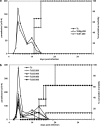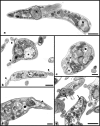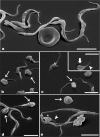In vitro and in vivo activities of 1,3,4-thiadiazole-2-arylhydrazone derivatives of megazol against Trypanosoma cruzi
- PMID: 20231395
- PMCID: PMC2863677
- DOI: 10.1128/AAC.01241-09
In vitro and in vivo activities of 1,3,4-thiadiazole-2-arylhydrazone derivatives of megazol against Trypanosoma cruzi
Abstract
From a series of 1,3,4-thiadiazole-2-arylhydrazone derivatives of megazol screened in vitro against Trypanosoma cruzi, eight (S1 to S8) were selected for in vivo screening by single-dose oral administration (200 mg/kg of body weight) to infected mice at 5 days postinfection (dpi). Based on significant decreases in both parasitemia levels and mortality rates, S2 and S3 were selected for further assays. Despite having no in vivo effect, S1 was included since it was 2-fold more potent against trypomastigotes than megazol in vitro. Trypomastigotes treated with S1, S2, or S3 showed alterations of the flagellar structure and of the nuclear envelope. When assayed on intracellular amastigotes, the selectivity index (SI) for macrophages was in the range of >27 to >63 and for cardiac cells was >32 for S1 and >48 for megazol. In noninfected mice, S1 did not alter the levels of glutamic oxalacetic transaminase (GOT), glutamate pyruvate transaminase (GPT), or urea. S2 led to an increase in GOT, S3 to increases in GOT and GPT, and megazol to an increase in GOT. Infected mice were treated with each derivative at 50 and 100 mg/kg from dpi 6 to 15: S1 did not interfere with the course of infection or reduce the number of inflammatory foci in the cardiac tissue, S2 led to a significant decrease of parasitemia, and S3 decreased mortality. There was no direct correlation between the in vitro effect on trypomastigotes and amastigotes and the results of the treatment in experimental models, as S1 showed a high potency in vitro while, in two different schemes of in vivo treatment, no decrease of parasitemia or mortality was observed.
Figures






Similar articles
-
1,3,4-Thiadiazole derivatives of R-(+)-limonene benzaldehyde-thiosemicarbazones cause death in Trypanosoma cruzi through oxidative stress.Microbes Infect. 2016 Dec;18(12):787-797. doi: 10.1016/j.micinf.2016.07.007. Epub 2016 Jul 30. Microbes Infect. 2016. PMID: 27484335
-
Synthesis and antitrypanosomal profile of new functionalized 1,3,4-thiadiazole-2-arylhydrazone derivatives, designed as non-mutagenic megazol analogues.Bioorg Med Chem Lett. 2004 Dec 20;14(24):5967-70. doi: 10.1016/j.bmcl.2004.10.007. Bioorg Med Chem Lett. 2004. PMID: 15546709
-
Effect of L-leucine methyl ester on growth and ultrastructure of Trypanosoma cruzi.Acta Trop. 2007 Jan;101(1):69-79. doi: 10.1016/j.actatropica.2006.12.006. Epub 2007 Jan 23. Acta Trop. 2007. PMID: 17250794
-
In Vitro and In Vivo Trypanosomicidal Action of Novel Arylimidamides against Trypanosoma cruzi.Antimicrob Agents Chemother. 2016 Mar 25;60(4):2425-34. doi: 10.1128/AAC.01667-15. Print 2016 Apr. Antimicrob Agents Chemother. 2016. PMID: 26856830 Free PMC article.
-
Synthesis and biological activity of nitro heterocycles analogous to megazol, a trypanocidal lead.J Med Chem. 2003 Jan 30;46(3):427-40. doi: 10.1021/jm021030a. J Med Chem. 2003. PMID: 12540242
Cited by
-
Megazol and its bioisostere 4H-1,2,4-triazole: comparing the trypanocidal, cytotoxic and genotoxic activities and their in vitro and in silico interactions with the Trypanosoma brucei nitroreductase enzyme.Mem Inst Oswaldo Cruz. 2014 Jun;109(3):315-23. doi: 10.1590/0074-0276140497. Epub 2014 Mar 18. Mem Inst Oswaldo Cruz. 2014. PMID: 24676659 Free PMC article.
-
Quantitative assessment of the nature of noncovalent interactions in N-substituted-5-(adamantan-1-yl)-1,3,4-thiadiazole-2-amines: insights from crystallographic and QTAIM analysis.RSC Adv. 2020 Mar 6;10(17):9840-9853. doi: 10.1039/d0ra00733a. eCollection 2020 Mar 6. RSC Adv. 2020. PMID: 35498588 Free PMC article.
-
Synthesis and trypanocidal activity of novel 2,4,5-triaryl-N-hydroxylimidazole derivatives.Molecules. 2013 Mar 15;18(3):3445-57. doi: 10.3390/molecules18033445. Molecules. 2013. PMID: 23503118 Free PMC article.
-
Screening of Potential anti-Trypanosoma cruzi Candidates: In Vitro and In Vivo Studies.Open Med Chem J. 2011;5:21-30. doi: 10.2174/1874104501105010021. Epub 2011 Mar 9. Open Med Chem J. 2011. PMID: 21629508 Free PMC article.
-
Antioxidant, antimicrobial, antiparasitic, and cytotoxic properties of various Brazilian propolis extracts.PLoS One. 2017 Mar 30;12(3):e0172585. doi: 10.1371/journal.pone.0172585. eCollection 2017. PLoS One. 2017. PMID: 28358806 Free PMC article.
References
-
- Aguirre, G., M. Bolani, H. Cerecetto, A. Gerpe, M. Gonzalez, Y. F. Sainz, A. Denicola, C. O. Ocariz, J. J. Nogal, D. Montero, and J. A. Escario. 2004. Novel antiprotozoal products: imidazole and benzimidazole N-oxide derivatives and related compounds. Arch. Pharm. 337:259-270. - PubMed
-
- Barrett, M. P., A. H. Fairlamb, B. Rousseau, G. Chauvière, and J. Périé. 2000. Uptake of the nitroimidazole drug megazol by African trypanosomes. Biochem. Pharmacol. 59:615-620. - PubMed
-
- Boechat, N., A. S. Carvalho, E. Fernandez-Ferreira, R. O. Soares, A. S. Souza, D. Gibaldi, M. Bozza, and A. C. Pinto. 2001. Novel nitroimidazoles with trypanocidal and cell growth inhibition activities. Cytobios 105:83-90. - PubMed
-
- Bouteille, B., A. Marie-Daragon, G. Chauvière, C. Albuquerque, B. Enanga, M. L. Darde, J. M. Vallat, J. Périé, and M. Dumas. 1995. Effect of megazol on Trypanosoma brucei brucei acute and subacute infections in Swiss mice. Acta Trop. 60:73-80. - PubMed
-
- Brener, Z. 1962. Therapeutic activity and criterion of cure on mice experimentally infected with Trypanosoma cruzi. Rev. Inst. Med. Trop. São Paulo 4:386-396. - PubMed
Publication types
MeSH terms
Substances
LinkOut - more resources
Full Text Sources
Medical

